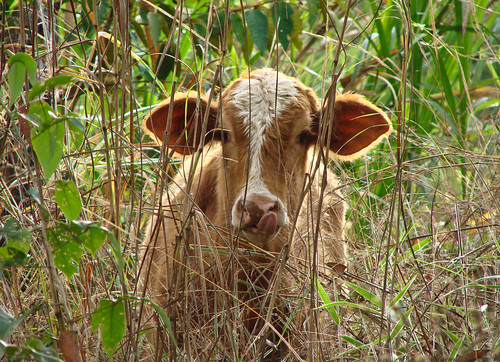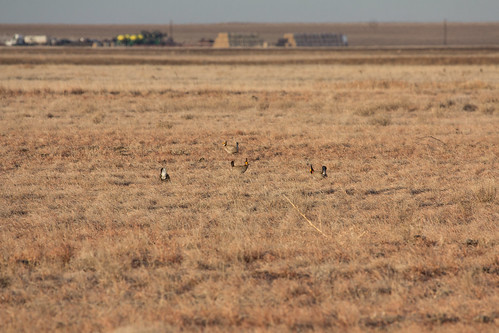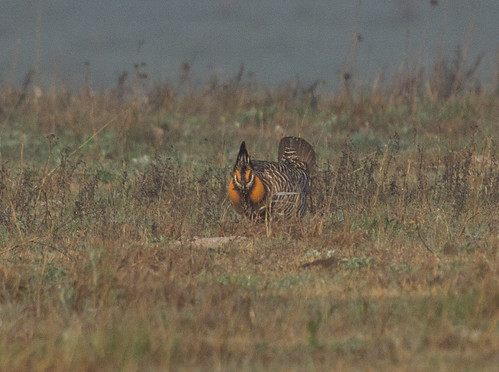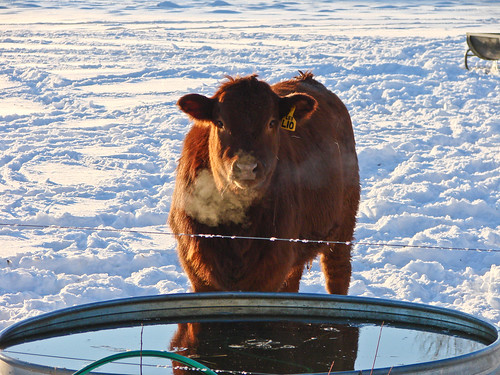This year I’ve been crisscrossing the nation looking for birds of conservation concern and trying to be mindful of all the issues affecting them. Some of these issues are huger than others, making me increasingly uncomfortable with things I do in my own life that contribute to their problems.
All year I’ve been seeing badly overgrazed countryside. In Colorado, the remaining populations of Lesser Prairie-Chickens and both species of sage grouse are dwindling because of habitat loss, much due to cattle production. In Kansas, I witnessed a heartbreaking sight—the last surviving Greater Prairie-Chicken on one lek putting his heart and soul into breeding displays with no other prairie chickens watching or responding to him. Lekking grounds are often on disturbed habitat—the birds display in the open where their antics can be seen to greatest advantage—but the habitat surrounding that lek on private land was also overgrazed. Fortunately, prairie chicken numbers are improving within the protected Cheyenne Bottoms, which includes public land managed by the Kansas Department of Wildlife and Parks and private land managed by The Nature Conservancy. But prairie chickens, like Florida Scrub-Jays, are homebodies, virtually never wandering more than a few miles from where they were hatched. Continued fragmentation of habitat means that small remnant groups are stuck where they are, and end up dying out. I saw my first Greater Prairie-Chickens in Michigan in 1976—that was the very last group in the state, and within a few years the entire species was gone forever from Michigan. I saw my first Lesser Prairie-Chickens near Campo, Colorado, in 1996—that local population is also lost now. One by one these small remnant populations die out. Our heavy consumption of beef is one of the main causes.
Driving through New Mexico was the last straw. Everywhere in the open landscape was badly overgrazed habitat, along with voracious cattle who don’t even get to enjoy the fruits of the landscape for long before they’re slaughtered, to be replaced by a never-ending supply of new cattle. Suddenly, out of the blue on July 19, I reached a breaking point. I’d needed a quick meal and quick use of the Internet while on the road a few days earlier and picked up a cheeseburger at McDonald’s. I didn’t want that to be the last beef I ever ate, so as I was leaving the Bosque del Apache National Wildlife Refuge, I stopped at a lovely little restaurant in San Antonio, New Mexico, called the Owl Bar and Café. Tom Kuenzli, a friend of mine who works at Eagle Optics, had introduced me to the café a couple of years ago when our paths intersected at the refuge’s annual Sandhill Crane festival, and he highly recommended their “green chili hamburger,” which has even achieved national acclaim. Now, because the café was right there, I decided I’d make their specialty the very last beef meal I’d eat. And now I’m done with it.
My decision didn’t even take into account other unsettling truths about beef production. A great deal of it takes place on huge feed lots, where the cattle are fed corn. Corn production involves more pesticides than other food crops, and much of it now is genetically modified to produce Bacillus thuringiensis, implicated in declining populations of Monarchs and other butterflies. Growing so much corn for cattle and for ethanol is taking up huge swaths of valuable grassland habitat. And waste and runoff from feed lots cause serious contamination of freshwater. (These issues were discussed extensively in my 101 Ways to Help Birds because #2 was “Eat lower on the food chain, and especially eat less beef.”)
One March sometime in the 1990s, on my way to the Rowe Sanctuary in Nebraska to see the huge Sandhill Crane migration, I found myself behind a cattle truck for well over a hundred miles, with one cow staring right at me the whole way. This was disconcerting enough to put me off beef for a couple of years. I’ll think of her, and of other cows that have stared me in the face, if my resolve ever grows weak.
When I mentioned I was quitting beef, my husband pointed out that this would mean giving up one of my favorite foods on the planet, Rocky Rococo’s sausage pizza. Virtually every time I drive through Madison, Wisconsin, I stop at a Rocky’s to get a slice. This was sobering, but I was steady in my resolve. Fortunately, a little research on the Internet revealed that Rocky’s Italian sausage is made with pork. At some point I’ll probably find myself giving that up, too, but for now, I’m simply telling myself, “Don’t have a cow, man.”
(Do notice the active nest in the last “c” in the sign. Apparently even robins approve of Rocky Rococo!)








Hi Laura- great article as usual! This summer, I traveled to Yellowstone as a co-instructor of a course about human-wolf conflicts surrounding the reintroduction to the national park. We met with both wolf biologists and ranchers to hear their perspectives. I was sorry to say that after visiting a ranch, I was further convinced that beef was in conflict with conservation. A particularly interesting tidbit from the head wolf biologist at the park was that wolves will attack bison last of the possible ungulate prey. This strengthened my prior leaning toward choosing bison meat over cow, when buying red meat at the grocery. While wolves will go after cattle, leading to ranchers wanting to “control” for them (shoot them), it seems bison will naturally deter them due to already-extant ecological relationships…